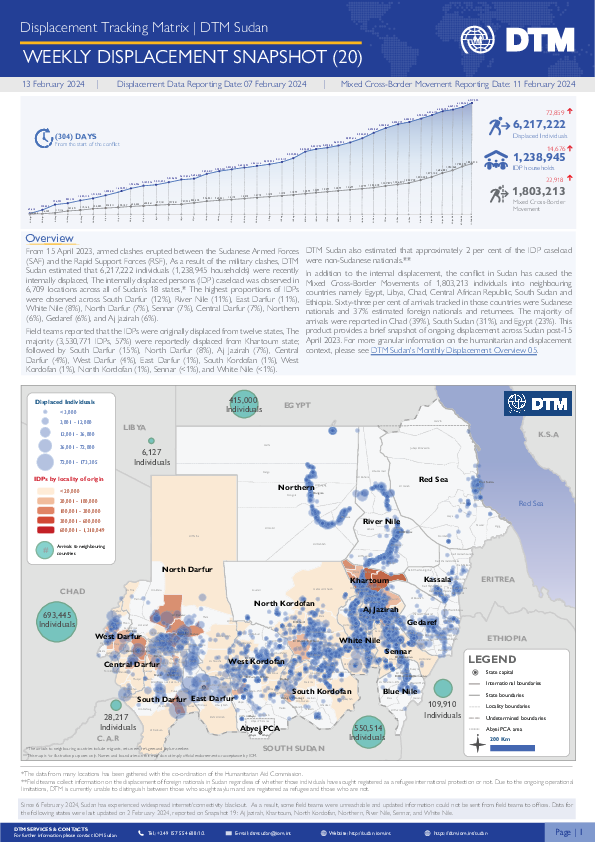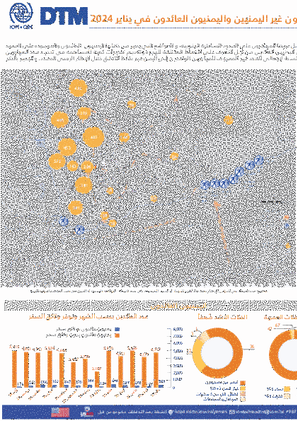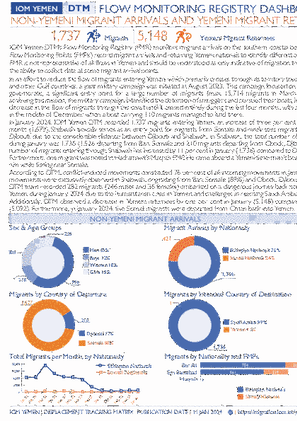-
Countries
-
Data and Analysis
-
Special Focus
-
Crisis Responses
Assessment Report

Contact
DTM Europe, DTMMediterranean@iom.int
Language
English
Location
Slovakia
Period Covered
Jan 01 2023
Dec 31 2023
Activity
- Survey
- Return Intention
Key findings
- Top countries of stay: Slovakia (77%), Czechia (3%), Austria (2%), United Kingdom (2%), Ireland (2%), Germany (2%).
- Intentions: 56% going for short visit, 37% plans to stay in Ukraine (prospective returnees), and 7% is undecided.
- Reasons for short visit*: meeting family (46%), seeking healthcare (19%), collecting documents (9%). (*more than one answer possible)
- Reasons for long stay*: returning from a short visit abroad (33%), did shopping abroad (11%), improved situation in place of origin (10%). (*more than one answer possible)
- Destinations in Ukraine: 83% travels to the region of origin, 16% to a different region in Ukraine, and 1% is undecided: Zakarpatska (42%), city of Kyiv (13%), Dnipropetrovska (6%).
- Top needs*: healthcare (22%), medication (13%), financial support (12%), general information (12%), employment support (11%). (*more than one answer possible)
- Households*: 14% travels with at least one infant (0-4 years-old), 56% travels with at least one child (5-17 years-old), 45% are single-headed households, and 14% travels with elderly (60+ years-old). (*more than one answer possible)

Contact
DTM Nigeria, iomnigeriadtm@iom.int
Language
English
Location
Nigeria
Period Covered
Jul 24 2023
Sep 08 2023
Activity
- Mobility Tracking
- Baseline Assessment
In Round 46, a total of 2,305,335 Internally Displaced Persons (IDPs) were identified in 472,239 households. This signifies a slight increase of less than one per cent (or 9,801 individuals) compared to Round 45 when 2,295,534 IDPs were recorded (June 2023). During Round 46, IDP assessments were conducted in 2,333 locations across the six states of north-east Nigeria. The assessed locations included 273 camps and camp-like settlements and 2,060 locations where internally displaced persons lived among host communities. Furthermore, 2,083,835 returnees were recorded in the Round 46 assessment. This number represents an increase of 8,578 individuals or less than one per cent compared to Round 45 when 2,075,257 returnees were recorded in June 2023.

Contact
DTMThailand@iom.int
Language
English
Location
Thailand
Period Covered
Oct 09 2023
Jan 24 2024
Activity
- Survey
- Site Assessment
This factsheet aims to provide a snapshot of multi-sectoral conditions, needs, and challenges among Myanmar migrants in Chiang Mai province as captured between October 2023 and January 2024 by IOM Thailand’s multi-sectoral assessment of needs. The purpose of this assessment is to provide insights regarding the severity of needs among migrant populations, identify vulnerable population groups and geographic areas with the most acute needs, inform assistance planning and relevant Sustainable Development Goals (SDGs) targets, and provide sectoral and inter-sectoral baselines for future assessments.

Contact
DTM Sudan; dtmsudan@iom.int
Language
English
Location
Sudan
Period Covered
Feb 03 2024
Feb 07 2024
Activity
- Mobility Tracking
- Baseline Assessment
Overview
From 15 April 2023, armed clashes erupted between the Sudanese Armed Forces (SAF) and the Rapid Support Forces (RSF) in multiple cities across Sudan. Clashes initially took place in cities across Northern and Khartoum states, later spreading across the Darfur and Kordofan regions.
Highlights
- DTM Sudan estimates that 6,217,222 individuals (1,238,945 households) were recently internally displaced.
- The IDP caseload was observed in 6,709 locations across all of Sudan’s 18 states.
- The highest proportions of IDPs were observed across South Darfur (12%), River Nile (11%), East Darfur (11%), White Nile (8%), North Darfur (7%), Sennar (7%), Central Darfur (7%), Northern (6%), Gedaref (6%), and Aj Jazirah (6%).
- Field teams reported that the IDPs observed were originally displaced from twelve states. The majority (3,530,771 IDPs, 57%) were reportedly displaced from Khartoum state; followed by South Darfur (15%), North Darfur (8%), Aj Jazirah (7%), Central Darfur (4%), West Darfur (4%), East Darfur (1%), South Kordofan (1%), West Kordofan (1%), North Kordofan (1%), Sennar (<1%), and White Nile (<1%).
- IOM-DTM also reported that an estimated 1,803,213 mixed cross-border movements were made into neighbouring countries.
- This product provides brief insights into those displaced in Sudan post-15 April 2023. For more granular information on the IDP caseload and the displacement context, please see IOM-DTM's Monthly Displacement Overview (05).
DISCLAIMER: Since 6 February 2024, Sudan has experienced widespread internet/connectivity blackout. As a result, some field teams were unreachable and updated information could not be sent from field teams to offices. Data for the following states were last updated on 2 February 2024, reported on Weekly Displacement Snapshot 19: Aj Jazirah, Khartoum, North Kordofan, Northern, River Nile, Sennar, and White Nile.

Contact
DTM Ethiopia, DTMEthiopia@iom.int
Language
English
Location
Ethiopia
Period Covered
Nov 25 2022
Jan 08 2023
Activity
- Mobility Tracking
- Village Assessment
This snapshot report will present data on returned migrants from abroad collected by the International Organization for Migration (IOM) through its Displacement Tracking Matrix (DTM) methodology and Village Assessment Survey (VAS) tool in the Amhara and Oromia regions of Ethiopia between November 2022 and January 2023. A total of 21,832 returned migrants from abroad were identified in 730 villages in Amhara region and 4,812 returned migrants from abroad were identified in 174 villages in Oromia region.

Contact
DTM Yemen, DTMYemen@iom.int
Language
English
Location
Yemen
Period Covered
Jan 01 2024
Jan 31 2024
Activity
- Flow Monitoring
- Mobility Tracking
- Baseline Assessment
تعمل مصفوفة تتبُع النزوح الخاصة بالمنظمة الدولية للهجرة في اليمن عبر سجل مراقبة التدفق في المواقع الرئيسية التي يصل عبرها المهاجرون على الحدود الساحلية الجنوبية، و المواقع التي يعبر من خلالها اليمنيون العائدون والموجودة على الحدود الشمالية لليمن مع المملكة العربية السعودية. يُراقب الباحثون المتمركزون في نقاط رصد تدفق وصول المهاجرين والمواطنين اليمنيين العائدين من أجل التعرف على الأنماط المختلفة للهجرة وتقديم تقديرات كمية للمساهمة في تحديد عدد المهاجرين الوافدين الى البلد. لا يشمل سجل مراقبة التدفق جميع نقاط التدفق في اليمن، ولكنه يمثل مؤشراً حول اتجاهات الهجرة بالنسبة لإجمالي العدد غير المعروف للمهاجرين الوافدين إلى اليمن عبر نقاط التدفق خلال الإطار الزمني المحدد. والجدير بالذكر أن القيود المفروضة على الوصول تَحُد من القدرة على جمع البيانات في بعض نقاط وصول المهاجرين.
في محاولة للحد من تدفق المهاجرين الذين يدخلون اليمن، والذي يعبر بشكل أساسي عبر أراضيه باتجاه المملكة العربية السعودية ودول الخليج الأخرى، بدأت حملة عسكرية مشتركة في أغسطس 2023، وركزت هذه الحملة على ساحل محافظة لحج، وهي نقطة دخول مهمة لعدد كبير من المهاجرين (بحد أقصى 15,714 مهاجرًا في مارس 2023). ولتحقيق هذه المهمة، كثفت الحملة العسكرية اعتقال المهربين وملاحقة قواربهم، مما أدى إلى انخفاض تدريجي في تدفق المهاجرين عبر هذا الساحل حتى توقف تماما خلال الأشهر الأربعة الماضية، مع استثناء واحد في منتصف ديسمبر، عندما تمكن قارب يحمل 110 مهاجرين من الوصول إلى ساحل لحج.
في يناير 2024، سجلت مصفوفة تتبع النزوح التابعة للمنظمة الدولية للهجرة في اليمن دخول 1,737 مهاجرًا إلى اليمن، بزيادة قدرها ثلاثة بالمائة مقارنة بالشهر الماضي (1,679). تعتبر شبوة عادة نقطة دخول للمهاجرين من الصومال ونادرا ما تشهد مغادرة المهاجرين من جيبوتي بسبب المسافة الكبيرة بين جيبوتي وشبوة. وفي شبوة، بلغ إجمالي عدد المهاجرين الذين وصلوا خلال شهر يناير 1,736 (1,526 غادروا من باري بالصومال و210 مهاجرين غادروا من أوبوك بجيبوتي). ارتفع العدد الإجمالي للمهاجرين الذين يدخلون عبر شبوة بنسبة 11 في المائة في يناير (1,736) مقارنة بشهر ديسمبر (1,569). علاوة على ذلك، تمت ملاحظة مهاجر واحد في منطقة المقرة بحضرموت. وجاء على متن قارب صيادين يمنيين كان يحمله أثناء الصيد بالقرب من الصومال.
وفقًا لمصفوفة تتبع النزوح، شكلت الحركات الناجمة عن النزاع 76 في المائة من جميع الحركات الواردة في يناير 2024. وقد لوحظت هذه الحركات حصريًا في شبوة، قادمة من باري، الصومال (89٪) وأوبوك، جيبوتي (11٪). سجل فريق مصفوفة تتبع النزوح في جيبوتي 282 مهاجرًا (246 ذكرًا و36 أنثى) انطلقوا في رحلة خطيرة للعودة إلى وطنهم بالقارب من اليمن خلال شهر يناير 2024 بسبب الأزمة الإنسانية في اليمن وتحديات الوصول إلى المملكة العربية السعودية.
بالإضافة إلى ذلك، لاحظت مصفوفة تتبع النزوح انخفاضًا في عدد العائدين اليمنيين بنسبة واحد بالمائة في يناير (5,148) مقارنة بشهر ديسمبر (5,092). علاوة على ذلك، في يناير 2024، تم ترحيل خمسة مهاجرين صوماليين من عمان إلى اليمن.

Contact
DTM Yemen, DTMYemen@iom.int
Language
English
Location
Yemen
Period Covered
Jan 01 2024
Jan 31 2024
Activity
- Flow Monitoring
- Mobility Tracking
- Baseline Assessment
IOM Yemen DTM’s Flow Monitoring Registry (FMR) monitors migrant arrivals on the southern coastal border and Yemeni return locations on Yemen's northern border with the Kingdom of Saudi Arabia (KSA). Enumerators placed at Flow Monitoring Points (FMPs) record migrant arrivals and returning Yemeni nationals to identify different patterns of migration, and to provide quantitative estimates to help define the population of irregular migrants entering the country. FMR is not representative of all flows in Yemen and should be understood as only indicative of migration trends of the unknown total number of migrants arriving in Yemen at FMPs during the time frame indicated. Access constraints limit the ability to collect data at some migrant arrival points.
In an effort to reduce the flow of migrants entering Yemen, which primarily crosses through its territory towards Saudi Arabia and other Gulf countries, a joint military campaign was initiated in August 2023. This campaign focused on the coast of Lahj governorate, a significant entry point for a large number of migrants (max. 15,714 migrants in March 2023). Towards achieving this mission, the military campaign intensified the detention of smugglers and pursued their boats, leading to a steady decrease in the flow of migrants through this coast until it ceased entirely during the last four months, with a single exception in the middle of December, when a boat carrying 110 migrants managed to land there.
In January 2024, IOM Yemen DTM recorded 1,737 migrants entering Yemen, an increase of three per cent compared to last month (1,679). Shabwah typically serves as an entry point for migrants from Somalia and rarely sees migrants departing from Djibouti due to the considerable distance between Djibouti and Shabwah. In Shabwah, the total number of migrants arrived during January was 1,736 (1,526 departing from Bari, Somalia and 210 migrants departing from Obock, Djibouti). The overall number of migrants entering through Shabwah has increased by 11 per cent in January (1,736) compared to December (1,569). Furthermore, one migrant was noted in Hadramawt's Maqrah FMP. He came aboard a Yemeni fishermen's boat that had carried him while fishing near Somalia.
According to DTM, conflict-induced movements constituted 76 per cent of all incoming movements in January 2024. These movements were exclusively observed in Shabwah, originating from Bari, Somalia (89%) and Obock, Djibouti (11%). Djibouti DTM team recorded 282 migrants (246 males and 36 females) embarked on a dangerous journey back home by boat from Yemen during January 2024 due to the humanitarian crisis in Yemen and challenges in reaching Saudi Arabia.
Additionally, DTM observed a decrease in Yemeni returnees by one per cent in January (5,148) compared to December (5,092). Furthermore, in January 2024, five Somali migrants were deported from Oman back into Yemen.
IOM Yemen DTM’s Flow Monitoring Registry (FMR) monitors migrant arrivals on the southern coastal border and Yemeni return locations on Yemen's northern border with the Kingdom of Saudi Arabia (KSA). Enumerators placed at Flow Monitoring Points (FMPs) record migrant arrivals and returning Yemeni nationals to identify different patterns of migration, and to provide quantitative estimates to help define the population of irregular migrants entering the country. FMR is not representative of all flows in Yemen and should be understood as only indicative of migration trends of the unknown total number of migrants arriving in Yemen at FMPs during the time frame indicated. Access constraints limit the ability to collect data at some migrant arrival points.
In an effort to reduce the flow of migrants entering Yemen, which primarily crosses through its territory towards Saudi Arabia and other Gulf countries, a joint military campaign was initiated in August 2023. This campaign focused on the coast of Lahj governorate, a significant entry point for a large number of migrants (max. 15,714 migrants in March 2023). Towards achieving this mission, the military campaign intensified the detention of smugglers and pursued their boats, leading to a steady decrease in the flow of migrants through this coast until it ceased entirely during the last four months, with a single exception in the middle of December, when a boat carrying 110 migrants managed to land there.
In January 2024, IOM Yemen DTM recorded 1,737 migrants entering Yemen, an increase of three per cent compared to last month (1,679). Shabwah typically serves as an entry point for migrants from Somalia and rarely sees migrants departing from Djibouti due to the considerable distance between Djibouti and Shabwah. In Shabwah, the total number of migrants arrived during January was 1,736 (1,526 departing from Bari, Somalia and 210 migrants departing from Obock, Djibouti). The overall number of migrants entering through Shabwah has increased by 11 per cent in January (1,736) compared to December (1,569). Furthermore, one migrant was noted in Hadramawt's Maqrah FMP. He came aboard a Yemeni fishermen's boat that had carried him while fishing near Somalia.
According to DTM, conflict-induced movements constituted 76 per cent of all incoming movements in January 2024. These movements were exclusively observed in Shabwah, originating from Bari, Somalia (89%) and Obock, Djibouti (11%). Djibouti DTM team recorded 282 migrants (246 males and 36 females) embarked on a dangerous journey back home by boat from Yemen during January 2024 due to the humanitarian crisis in Yemen and challenges in reaching Saudi Arabia.
Additionally, DTM observed a decrease in Yemeni returnees by one per cent in January (5,148) compared to December (5,092). Furthermore, in January 2024, five Somali migrants were deported from Oman back into Yemen.

Contact
dtmlebanon@iom.int
Language
English
Location
Lebanon
Period Covered
Oct 10 2023
Feb 06 2024
Activity
- Mobility Tracking
- Baseline Assessment
Since October 8 there has been an increase in cross-border incidents between Israel and Lebanon, resulting in the displacement of people both within the South and elsewhere within the country. Since October 10, the Displacement Tracking Matrix (DTM) has been conducting the daily monitoring of population movements. The objective of the exercise is to inform preparedness and response planning.

Contact
DTMUkraine@iom.int
Language
English
Location
Ukraine
Period Covered
Nov 27 2023
Dec 27 2023
Activity
- Survey
Between 27 November and 27 December 2023, the International Organization for Migration (IOM) conducted Round 15 of the General Population Survey (GPS), a highly representative assessment of internal displacement in Ukraine. Fifty data collection experts conducted the assessment screener phone-based interviews with 20,000 randomly selected respondents and follow-up interviews with 1,517 IDPs, 1,541 returnees, and 2,002 residents, using the Computer-Assisted Telephone Interview (CATI) methodology and a Random Digit Dial (RDD) approach.
This report provides the main findings from Round 15 of the GPS, including detailed insights into population figures, displacement flows and mobility intentions, demographic profiles, household composition and vulnerabilities, and needs of the displaced population, to facilitate evidence-based decision-making on strategic, technical, and programmatic aspects of the response and recovery efforts in Ukraine.

Contact
DTM Europe, DTMMediterranean@iom.int
Language
Bosnian, Croatian, Serbian
Location
Serbia
Period Covered
Dec 15 2023
Dec 29 2023
Activity
- Survey
- Flow Monitoring
Ovaj izveštaj pruža uvid u profile, iskustva i putovanja migranata koji su u tranzitu u Republici Srbiji. Podaci su prikupljeni od 15. do 29. decembra 2023. zajedno sa Komesarijatom za izbeglice i migracije Republike Srbije (KIRS). Ukupno je intervjuisano 112 migranata u šest centara širom zemlje (AC Banja Koviljača, PC Pirot, AC Obrenovac, PC Bujanovac, AC Krnjača, PC Preševo).
Pagination
- Previous page
- Page 51
- Next page
